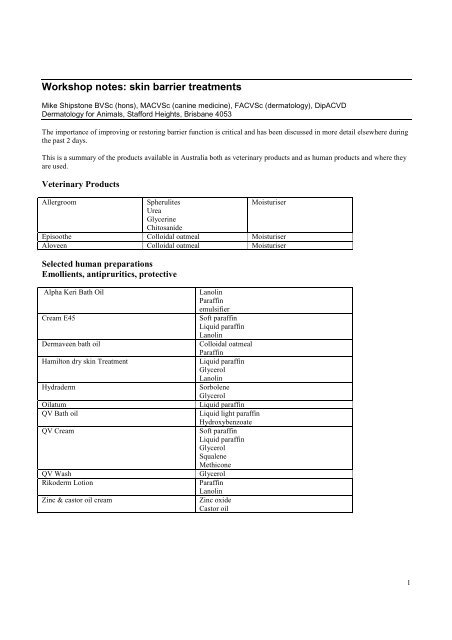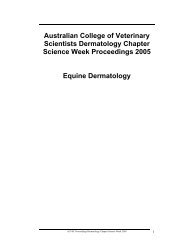Workshop: skin barrier treatments
Workshop: skin barrier treatments
Workshop: skin barrier treatments
You also want an ePaper? Increase the reach of your titles
YUMPU automatically turns print PDFs into web optimized ePapers that Google loves.
<strong>Workshop</strong> notes: <strong>skin</strong> <strong>barrier</strong> <strong>treatments</strong><br />
Mike Shipstone BVSc (hons), MACVSc (canine medicine), FACVSc (dermatology), DipACVD<br />
Dermatology for Animals, Stafford Heights, Brisbane 4053<br />
The importance of improving or restoring <strong>barrier</strong> function is critical and has been discussed in more detail elsewhere during<br />
the past 2 days.<br />
This is a summary of the products available in Australia both as veterinary products and as human products and where they<br />
are used.<br />
Veterinary Products<br />
Allergroom Spherulites<br />
Urea<br />
Glycerine<br />
Chitosanide<br />
Moisturiser<br />
Episoothe Colloidal oatmeal Moisturiser<br />
Aloveen Colloidal oatmeal Moisturiser<br />
Selected human preparations<br />
Emollients, antipruritics, protective<br />
Alpha Keri Bath Oil Lanolin<br />
Paraffin<br />
emulsifier<br />
Cream E45 Soft paraffin<br />
Liquid paraffin<br />
Lanolin<br />
Dermaveen bath oil Colloidal oatmeal<br />
Paraffin<br />
Hamilton dry <strong>skin</strong> Treatment Liquid paraffin<br />
Glycerol<br />
Lanolin<br />
Hydraderm Sorbolene<br />
Glycerol<br />
Oilatum Liquid paraffin<br />
QV Bath oil Liquid light paraffin<br />
Hydroxybenzoate<br />
QV Cream Soft paraffin<br />
Liquid paraffin<br />
Glycerol<br />
Squalene<br />
Methicone<br />
QV Wash Glycerol<br />
Rikoderm Lotion Paraffin<br />
Lanolin<br />
Zinc & castor oil cream Zinc oxide<br />
Castor oil<br />
1
Psoriasis, seborrhoea, ichthyosis<br />
Alphosyl lotion Allantoin<br />
Coal tar<br />
Scale reduction<br />
Calmurid Urea<br />
Lactic acid<br />
Dry, hyperkeratosis<br />
Dermadrate Urea<br />
Lactic acid<br />
Dry, hyperkeratosis<br />
Egoderm ointment Ichthammol (Ammonium<br />
bituminosulfonate)<br />
Zinc oxide<br />
Petrolatum<br />
Dry fissured <strong>skin</strong><br />
Hamilton dry <strong>skin</strong> treatment Urea<br />
Petrolatum<br />
Dry <strong>skin</strong><br />
Nutraplus Urea Dry, hyperkeratosis<br />
Urecare / Urederm Urea Dry, hyperkeratosis<br />
Soap<br />
Made by reacting fats with sodium hydroxide (lye), which produces a strongly alkaline product. Washing with soap<br />
disturbs <strong>barrier</strong> function by extracting lipids, increasing TEWL and pH. May be particularly important given that dogs<br />
already have more neutral <strong>skin</strong> pH than humans.<br />
Actives and actions<br />
Lanolin Stable emulsion of water and wool wax (esters, fatty acids and high mole’ wt<br />
alcohol)<br />
Absorbed into <strong>skin</strong>, softens it and prevents drying<br />
Can be used as a carrier to deliver drugs SQ<br />
Petrolatum<br />
Paraffin<br />
Glycerin<br />
Propylene glycol<br />
Urea<br />
Lactic acid<br />
Colloidal oatmeal<br />
Allantoin<br />
Condensation<br />
products<br />
Imidazolidinyl urea<br />
Diazolidinyl urea<br />
Ichthammol<br />
(Ammonium<br />
bituminosulfonate)<br />
Also acts as occlusive agent<br />
Occlusive agents.<br />
Forms hydrophobic layer on <strong>skin</strong> surface (but petrolatum may penetrate into<br />
superficial SC) which traps water in epidermis below<br />
Humectants/hygroscopic agents<br />
Draw water from deeper dermis into St. corneum<br />
May have some keratolytic effect by increasing desquamation, due to<br />
improved St. C hydration<br />
Sulphonated shale oil. It has anti-inflammatory, bactericidal and fungicidal<br />
properties.<br />
Zinc oxide Calamine (ZnO mixed with 1% iron oxide)<br />
Used for insect bite, rash from contact irritants, but no firm evidence exists to<br />
support claims<br />
Whilst there are a large number of available products there is a lot of direct duplication (i.e. different products share the<br />
same active ingredient list) and the actions of all of the actives can really be divided into 2 broad classes: Occlusive agents<br />
and Humectants (hygroscopic agents)<br />
Despite the extensive range available there is no need to stock more than one example of a particular active ingredient<br />
combination. In our practice we commonly use the following for topical use at changing / improving <strong>barrier</strong> function:<br />
2
Allergroom<br />
Episoothe (Aloveen)<br />
Alpha Keri Bath Oil<br />
Hydraderm<br />
Oral EFA’s<br />
The most common use is on dry scaly <strong>skin</strong> and in areas of significant lichenification. Examples will be shown during the<br />
discussion.<br />
More recently a new class of products has been produced which contain ceramides, cholesterol, phytosphingosine and free<br />
fatty acids, ± occlusives petrolatum &/ glycerin. The rationale of these products is to act as lipid replacement moisturizers,<br />
correcting the lipid abnormalities that may occur in Atopic dermatitis. There is very little (no) published data to support the<br />
claims of restoring St. corneum function.<br />
There is a range of veterinary products that contain similar actives but they are not yet available in Australia.<br />
Further Reading<br />
Rosenkrantz, W. Practical Applications of Topical Therapy for Allergic, Infectious and Seborrheic Disorders. 2006. Clin<br />
Tech Small Anim Pract 21: 106-116<br />
Sugarman, J.L. The Epidermal Barrier in Atopic Dermatitis. Semin Cutan Med Surg. 2008 27: 108-114<br />
3
















